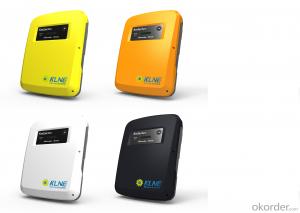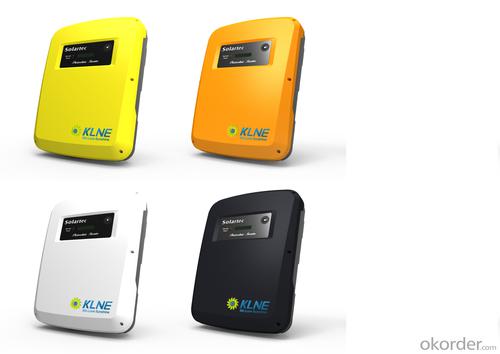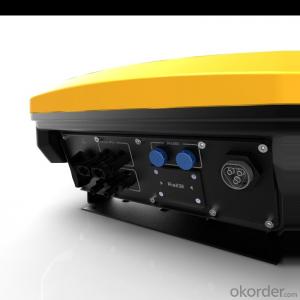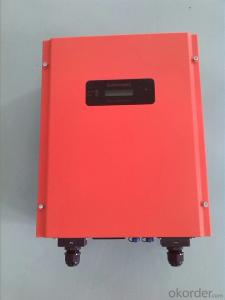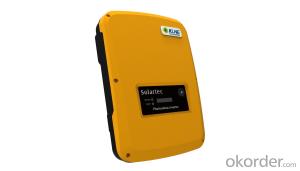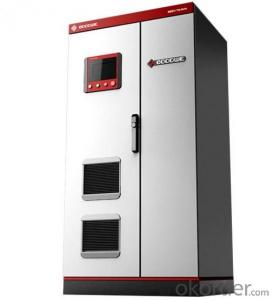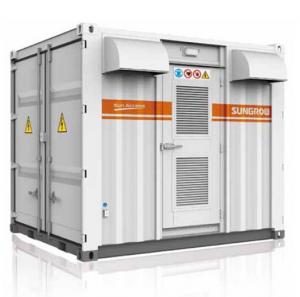Mtn Solar Inverter Solartec Central 100 On-Grid Inverter
- Loading Port:
- China Main Port
- Payment Terms:
- TT OR LC
- Min Order Qty:
- -
- Supply Capability:
- -
OKorder Service Pledge
Quality Product, Order Online Tracking, Timely Delivery
OKorder Financial Service
Credit Rating, Credit Services, Credit Purchasing
You Might Also Like
Solartec Central 100 uses a low frequency transformer. It securely connects the inverter to the grid. The wide range of DC input raises the g
enerating efficiency and return, and facilitates the combination of PV modules. The highest working altitude is 6000m (If above 3000m, it sho
uld be derated before use.) and is suitable for use in various geographical environments.
Efficient
■ Efficiency of up to 98.3 %
Flexible
■ Reactive power supply
■ Extended temperature range from -25°C ~ +55°C
■ Compact dimensions, easier installation
Reliable
■ Active and passive islanding detection
■ Powerful grid management function
■ Low-voltage ride through function
Communicative
■ Optical fiber remote monitoring
- Q: Can a solar inverter be upgraded or expanded?
- Yes, a solar inverter can be upgraded or expanded. Upgrades may involve adding new features or improving the efficiency of the existing inverter. Expansion typically refers to increasing the capacity of the inverter to accommodate additional solar panels. However, the extent to which an inverter can be upgraded or expanded varies depending on the specific model and manufacturer.
- Q: Can a solar inverter be used with solar-powered air conditioning systems?
- Yes, a solar inverter can be used with solar-powered air conditioning systems. The solar inverter is responsible for converting the direct current (DC) generated by the solar panels into alternating current (AC) that can be used to power various electrical appliances, including air conditioning units. By connecting the solar inverter to the solar panels and the air conditioning system, the generated solar energy can be efficiently utilized to power the AC system.
- Q: What is maximum power point tracking (MPPT) in a solar inverter?
- The technique known as maximum power point tracking (MPPT) is employed in solar inverters for the purpose of optimizing the power output of a photovoltaic (PV) system. When solar panels are exposed to sunlight, they generate electricity, but the amount of power they produce can vary depending on factors such as temperature, shading, and the angle at which sunlight strikes them. The maximum power point (MPP) is the specific point at which a solar panel generates the greatest amount of power given the prevailing environmental conditions. However, because these conditions are constantly changing, it is crucial to continuously track the MPP in order to ensure that the solar panels achieve the highest possible power output. Solar inverters equipped with MPPT functionality employ advanced algorithms and electronics to continuously monitor the voltage and current output of the solar panels. By dynamically adjusting the operating voltage and current to align with the MPP, the MPPT inverter ensures that the solar panels operate at their most efficient, regardless of how the environmental conditions may change. When the solar panels are functioning at their MPP, the MPPT inverter extracts the maximum amount of power from the panels and converts it into usable AC power. This optimization leads to increased overall energy generation and maximizes the return on investment for solar power systems. In addition to enhancing efficiency, MPPT also provides other advantages. It can compensate for fluctuations in solar irradiation, temperature, or shading that might impact the power output of the panels. By continually tracking the MPP, the MPPT inverter adjusts the operating parameters to minimize the impact of these factors, ensuring a consistent and optimal power output. In summary, MPPT is a critical feature in solar inverters as it maximizes the power output of a PV system by continuously tracking and adjusting the operating parameters to align with the MPP. This technology enables solar power systems to operate at their highest efficiency, enhance energy generation, and maximize the benefits of utilizing renewable energy sources.
- Q: Is it possible to upgrade my existing solar inverter without replacing the entire system?
- Yes, it is possible to upgrade an existing solar inverter without replacing the entire system. In many cases, solar inverters can be upgraded by simply replacing the existing inverter with a newer model that offers more advanced features or higher capacity. However, it is important to consult with a professional solar installer to determine the compatibility of the new inverter with your current system and ensure a successful upgrade.
- Q: What is the role of a power monitoring feature in a solar inverter?
- The role of a power monitoring feature in a solar inverter is to track and measure the amount of power generated by the solar panels. It provides real-time data on the energy production, allowing users to monitor the system's performance, identify any issues or inefficiencies, and optimize the overall energy output. This feature is crucial for ensuring the effective and efficient operation of a solar power system.
- Q: How does a solar inverter handle voltage sag or drop in the grid?
- A solar inverter handles voltage sag or drop in the grid by continuously monitoring the grid voltage. When it detects a drop below a certain threshold, it adjusts its own output voltage to compensate and maintain a stable and consistent voltage supply to the connected solar panels or the grid. This ensures that the solar system operates optimally and can seamlessly adapt to any fluctuations in the grid voltage.
- Q: How does a solar inverter handle variations in solar panel tilt and orientation?
- A solar inverter can handle variations in solar panel tilt and orientation by continuously adjusting its output voltage and current to match the changing conditions. It does this through a process called maximum power point tracking (MPPT), which optimizes the energy output of the solar panels by finding the point where the panels generate the maximum power. By dynamically adjusting the voltage and current, the solar inverter ensures that it operates at the optimal point, regardless of the tilt or orientation of the panels. This allows for efficient energy conversion and maximizes the overall power generation from the solar system.
- Q: What are the key factors affecting the cost of a solar inverter?
- The key factors affecting the cost of a solar inverter include its power capacity, efficiency, technology type, brand reputation, warranty, additional features, and installation requirements.
- Q: Can a solar inverter be used with a net metering system?
- Yes, a solar inverter can be used with a net metering system. A solar inverter is an essential component of a solar power system as it converts the direct current (DC) generated by solar panels into usable alternating current (AC) electricity. Net metering allows for the excess electricity produced by the solar panels to be fed back into the grid, resulting in credit or compensation from the utility company. The solar inverter facilitates this process by ensuring that the electricity generated by the solar panels is synchronized with the grid, allowing for seamless integration and net metering.
- Q: Can a solar inverter be used with electric vehicles?
- No, a solar inverter cannot directly be used with electric vehicles. Solar inverters are designed to convert DC (direct current) from solar panels into AC (alternating current) for home or grid use. Electric vehicles, on the other hand, require DC power to charge their batteries. However, solar energy generated through a solar inverter can be used to charge the batteries of an electric vehicle indirectly by connecting the solar system to the power grid or using a separate charging station equipped with a suitable DC charger.
Send your message to us
Mtn Solar Inverter Solartec Central 100 On-Grid Inverter
- Loading Port:
- China Main Port
- Payment Terms:
- TT OR LC
- Min Order Qty:
- -
- Supply Capability:
- -
OKorder Service Pledge
Quality Product, Order Online Tracking, Timely Delivery
OKorder Financial Service
Credit Rating, Credit Services, Credit Purchasing
Similar products
Hot products
Hot Searches
Related keywords
